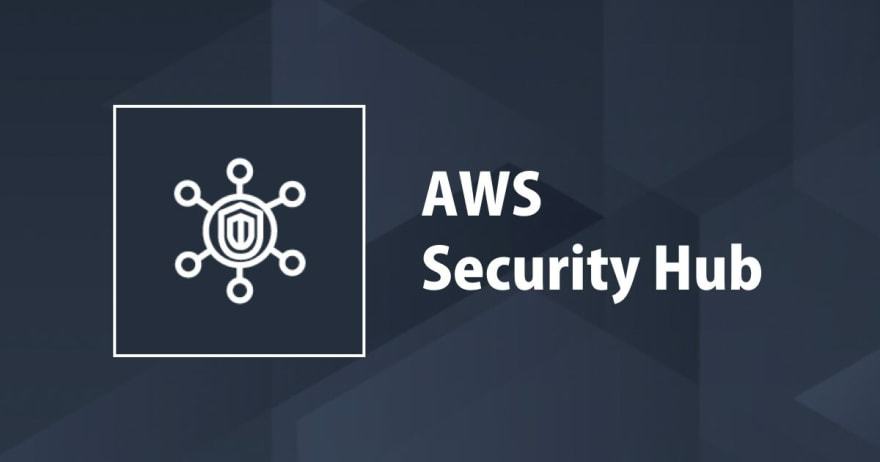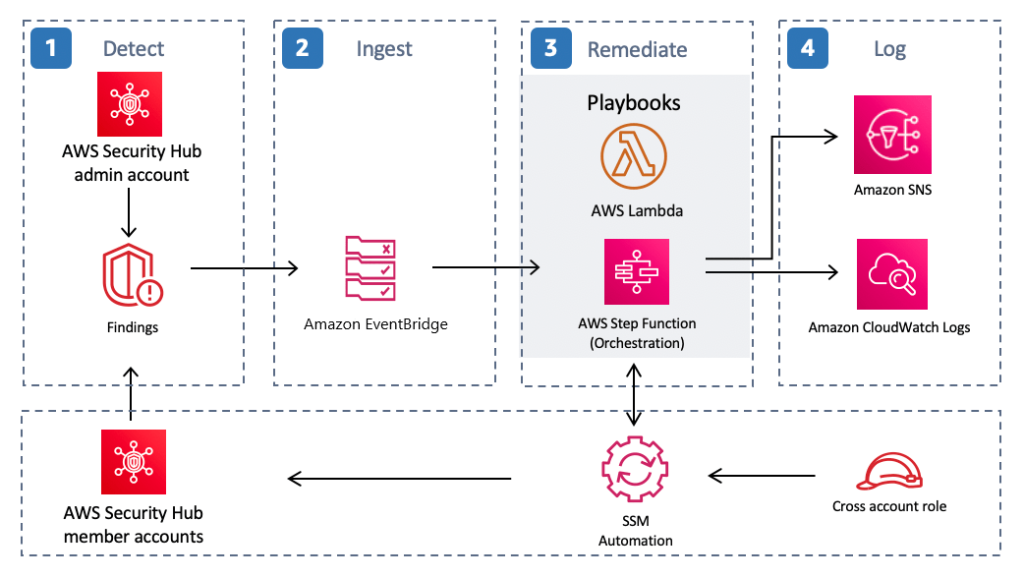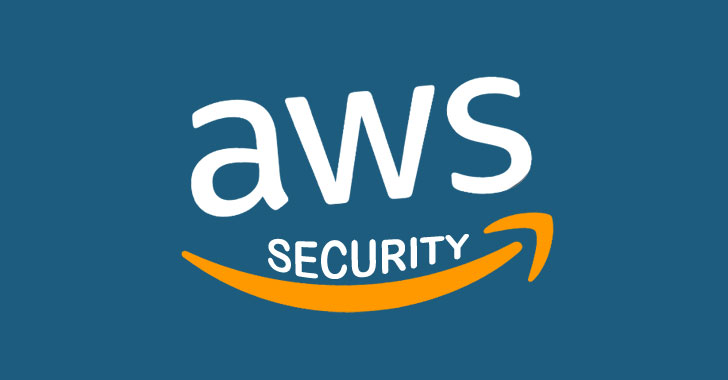What is AWS Security Hub?

AWS Security Hub is a security service provided by Amazon Web Services (AWS) that helps organizations centrally manage and monitor their security and compliance posture across their AWS accounts and resources. It offers a range of features and capabilities to help organizations identify security threats, vulnerabilities, and compliance issues.
AWS Security Hub is a valuable tool for organizations seeking to enhance their AWS security and compliance posture. It provides a centralized and automated way to identify and respond to security threats and vulnerabilities in AWS environments.
Top 10 use cases of AWS Security Hub:
Here are the top 10 use cases of AWS Security Hub:
- Centralized Security Monitoring: AWS Security Hub provides a centralized dashboard and console for monitoring the security status of all AWS accounts and resources within an organization.
- Continuous Security Monitoring: It continuously monitors AWS resources and services, looking for security threats, vulnerabilities, and deviations from security best practices.
- Security Threat Detection: Security Hub uses automated threat detection checks to identify potential security issues, including suspicious activities, unauthorized access, and malware.
- Vulnerability Management: It performs vulnerability assessments on AWS resources, highlighting known vulnerabilities and misconfigurations that need attention.
- Compliance and Benchmarking: AWS Security Hub helps organizations maintain compliance with industry standards and regulations by providing compliance checks and recommendations. It supports standards like CIS AWS Foundations Benchmark, PCI DSS, and more.
- Security Incident Response: Security Hub generates security findings and alerts for potential security incidents. It integrates with AWS CloudWatch Events and AWS Lambda for automated incident response.
- Security Automation: Organizations can create automated response workflows for security findings, helping to remediate issues more quickly and efficiently.
- Integration with AWS Services: AWS Security Hub integrates with various AWS services, including AWS Config, AWS CloudTrail, AWS GuardDuty, and more, to provide a comprehensive view of security data.
- Custom Insights: Users can create custom insights and security dashboards to visualize and analyze security data tailored to their specific requirements.
- Third-Party Security Tool Integration: Security Hub allows integration with third-party security tools and solutions to consolidate security findings from multiple sources into a single dashboard.
- Resource Prioritization: It helps organizations prioritize and address security findings based on severity, helping them focus on the most critical issues first.
- Security Best Practices: AWS Security Hub provides recommendations for security best practices, helping organizations improve their security posture over time.
- Multi-Account and Multi-Region Support: Organizations with multiple AWS accounts and resources across different regions can use Security Hub to gain a unified view of their security posture.
- Custom Actions: Users can define custom actions to take in response to security findings, such as notifying specific personnel or initiating remediation processes.
What are the feature of AWS Security Hub?
AWS Security Hub is a security and compliance service provided by Amazon Web Services (AWS) that offers features and capabilities to help organizations monitor their AWS accounts and resources for security threats and compliance issues. Here are the key features of AWS Security Hub, along with an overview of how it works and its typical architecture:
Key Features of AWS Security Hub:
- Centralized Security Dashboard: AWS Security Hub provides a centralized dashboard and console where organizations can view security findings and compliance status across their AWS accounts and regions.
- Continuous Security Monitoring: It continuously monitors AWS resources and services, automatically identifying security threats, vulnerabilities, and deviations from best practices.
- Security Threat Detection: Security Hub leverages automated threat detection checks to identify and categorize potential security issues, including suspicious activities, unauthorized access, and malware.
- Vulnerability Management: It performs vulnerability assessments on AWS resources, identifying known vulnerabilities and misconfigurations that require attention.
- Compliance and Benchmarking: AWS Security Hub supports compliance checks against industry standards and regulations, including CIS AWS Foundations Benchmark, PCI DSS, HIPAA, and others. It provides compliance findings and recommendations.
- Security Incident Response: Security findings generated by Security Hub can be integrated with AWS CloudWatch Events and AWS Lambda for automated incident response actions.
- Security Automation: Organizations can create automated response workflows based on security findings, enabling quicker and more efficient issue remediation.
- Custom Insights and Dashboards: Users can create custom insights, security dashboards, and reports to visualize and analyze security data that aligns with their specific requirements.
- Integration with AWS Services: Security Hub integrates with various AWS services, including AWS Config, AWS CloudTrail, AWS GuardDuty, AWS Identity and Access Management (IAM), and more, to consolidate security findings and provide a comprehensive view of security data.
- Resource Prioritization: It helps organizations prioritize security findings based on severity, allowing them to focus on addressing the most critical issues first.
How AWS Security Hub works and Architecture?

- Data Collection: AWS Security Hub collects security findings and compliance data from various AWS services, including AWS Config, AWS CloudTrail, AWS GuardDuty, and third-party security tools that are integrated with Security Hub.
- Automated Threat Detection: Security Hub performs automated threat detection checks on the collected data to identify potential security threats, vulnerabilities, and compliance issues.
- Security Findings: When security issues are detected, Security Hub generates security findings, categorizes them, and assigns severity levels to each finding.
- Dashboard and Insights: Security findings are displayed in the Security Hub console, where users can access a centralized dashboard, view findings, and create custom insights and dashboards.
- Compliance Checks: Compliance checks are performed against selected industry standards and regulations, and compliance findings are generated along with recommendations for remediation.
- Incident Response and Automation: Organizations can set up automated response actions using AWS Lambda functions and AWS CloudWatch Events to remediate security findings.
The architecture of AWS Security Hub is designed to collect, analyze, and present security data from various sources across AWS environments:
- Security Hub Service: This is the core service responsible for collecting, analyzing, and displaying security findings. It provides the centralized console for security monitoring and management.
- Data Sources: AWS Security Hub collects security data from various sources, including AWS Config, AWS CloudTrail, AWS GuardDuty, and integrated third-party security tools. These data sources provide insights into AWS resource configurations, activities, and security threats.
- Security Findings: Security findings are generated based on automated threat detection checks, vulnerability assessments, and compliance checks. Each finding is categorized and assigned a severity level.
- Custom Insights and Dashboards: Users can create custom insights and dashboards to visualize security data in a way that aligns with their specific security monitoring needs.
- Automated Remediation: Security findings can trigger automated response actions, allowing organizations to respond quickly to security threats and vulnerabilities.
- Integration with AWS Services: Security Hub integrates with other AWS services, such as AWS Lambda and AWS CloudWatch Events, to enable automated incident response and remediation workflows.
AWS Security Hub’s architecture is designed to provide organizations with a comprehensive view of their AWS security and compliance posture, helping them proactively identify and address security threats and vulnerabilities in their AWS environments.
How to Install AWS Security Hub?
To install AWS Security Hub, you can follow these steps:
- Go to the AWS console and sign in with your AWS account.
- In the search bar, type “Security Hub” and select “Security Hub”.
- On the Security Hub overview page, click “Enable Security Hub”.
- On the Enable Security Hub page, select the AWS regions that you want to enable Security Hub for.
- Click “Enable”.
Security Hub will now be installed and enabled for your AWS regions.
Once Security Hub is installed, you can start using it to monitor and protect your AWS resources. Here are some of the things that you can do with Security Hub:
- View your security posture: Security Hub provides you with a comprehensive overview of your security posture, including recommendations for how to improve your security.
- Monitor your security: Security Hub continuously monitors your AWS resources for threats and vulnerabilities.
- Protect your resources: Security Hub can help you protect your AWS resources from threats and vulnerabilities.
- Respond to incidents: Security Hub can help you respond to security incidents quickly and effectively.
Some additional tips for using Security Hub:
- Use the AWS Security Hub Documentation to learn more about how to use Security Hub to protect your AWS resources.
- Join the AWS Security Hub community forum to ask questions and get help from other AWS Security Hub users.
- Take advantage of the AWS Security Hub free trial to try out AWS Security Hub before you commit to a paid subscription.
AWS Security Hub is a powerful security tool that can help you improve the security of your AWS resources. By following these basic tutorials, you can get started with AWS Security Hub quickly and easily.
Basic Tutorials of AWS Security Hub: Getting Started

The following are the steps of basic tutorial of AWS Security Hub:
1. Enable AWS Security Hub
- Go to the AWS Console and sign in with your AWS account.
- In the search bar, type “Security Hub” and select “Security Hub”.
- On the Security Hub overview page, click “Enable Security Hub”.
- On the Enable Security Hub page, select the AWS regions that you want to enable Security Hub for.
- Click “Enable”.
2. Configure AWS Security Hub
Once AWS Security Hub is enabled, you can configure it to meet your specific needs. You can configure the following:
- Security Hub integration: You can integrate Security Hub with other AWS services and third-party security products. This will give you a more comprehensive view of your security posture.
- Security Hub alerts: You can configure Security Hub to send you alerts when certain security findings are generated.
- Security Hub compliance reports: You can generate Security Hub compliance reports to show your compliance with various security standards and regulations.
3. Analyze security findings
AWS Security Hub generates security findings based on data from AWS services and third-party security products. You can analyze these findings to identify potential security risks and take action to mitigate them.
To analyze security findings, you can use the Security Hub console or the Security Hub API. The Security Hub console provides a user-friendly interface for viewing and analyzing security findings. The Security Hub API allows you to automate tasks such as filtering and sorting security findings.
4. Remediate security findings
Once you have identified a security risk, you can remediate it by following the recommendations provided by AWS Security Hub.
To remediate security findings, you can use the Security Hub console or the Security Hub API. The Security Hub console provides a user-friendly interface for remediating security findings. The Security Hub API allows you to automate tasks such as remediating security findings and generating reports.
5. Monitor your security posture over time
AWS Security Hub provides you with a dashboard that shows you your overall security posture over time. You can use this dashboard to track your progress in improving your security posture.
The Security Hub dashboard provides you with a variety of metrics, such as the number of security findings, the severity of security findings, and the trends in security findings over time. You can use these metrics to identify areas where you need to improve your security posture.
Some additional tips for using AWS Security Hub:
- Use filters and tags to organize your security findings. This will make it easier to find the findings that are most relevant to you.
- Use the AWS Security Hub API to automate tasks such as remediating security findings and generating reports.
- Take advantage of the AWS Security Hub documentation and community forum to learn more about how to use AWS Security Hub to protect your AWS resources.
AWS Security Hub is a powerful security tool that can help you improve the security of your AWS resources. By following these basic tutorials and tips, you can get the most out of AWS Security Hub.
Email- contact@devopsschool.com

 Starting: 1st of Every Month
Starting: 1st of Every Month  +91 8409492687
+91 8409492687  Contact@DevOpsSchool.com
Contact@DevOpsSchool.com
